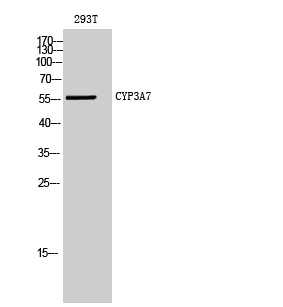
| WB | 咨询技术 | Human,Mouse,Rat |
| IF | 咨询技术 | Human,Mouse,Rat |
| IHC | 咨询技术 | Human,Mouse,Rat |
| ICC | 技术咨询 | Human,Mouse,Rat |
| FCM | 咨询技术 | Human,Mouse,Rat |
| Elisa | 1/20000 | Human,Mouse,Rat |
| Aliases | CYP3A7; Cytochrome P450 3A7; CYPIIIA7; Cytochrome P450-HFLA |
| Entrez GeneID | 100861540;1551; |
| WB Predicted band size | 50kDa |
| Host/Isotype | Rabbit IgG |
| Antibody Type | Primary antibody |
| Storage | Store at 4°C short term. Aliquot and store at -20°C long term. Avoid freeze/thaw cycles. |
| Species Reactivity | Human |
| Immunogen | Synthesized peptide derived from the Internal region of human CYP3A7. |
| Formulation | Purified antibody in PBS with 0.05% sodium azide,0.5%BSA and 50% glycerol. |
+ +
以下是关于CYP3A7抗体的3篇参考文献及其摘要概括:
---
1. **文献名称**:*"Expression of CYP3A4. CYP3A5. and CYP3A7 in human fetal and adult liver"*
**作者**:Hakkola J, Raunio H, Purkunen R, et al.
**摘要**:该研究通过免疫印迹和抗体检测,揭示了CYP3A7在胎儿肝脏中高表达,而CYP3A4在成人肝脏中占主导,表明两者在发育阶段的代谢功能差异。
2. **文献名称**:*"Developmental expression of CYP3A7 in human liver: Comparison with CYP3A4 and CYP3A5"*
**作者**:Sim SC, Edwards RJ, Boobis AR, et al.
**摘要**:利用特异性抗体分析不同年龄段的肝脏样本,发现CYP3A7在胎儿期显著表达,出生后逐渐减少,但部分成人肝脏中仍可检测到残留活性。
3. **文献名称**:*"CYP3A7 protein expression is correlated with the fetal liver development"*
**作者**:Kitaori N, Oda S, Yokoi T.
**摘要**:通过免疫组化实验,研究证实CYP3A7抗体标记的蛋白在胎儿肝脏中广泛分布,提示其在胚胎期类固醇代谢和药物清除中的关键作用。
---
以上文献均涉及CYP3A7抗体的应用,研究重点包括该酶在发育阶段的表达模式及功能差异。如需具体实验细节(如抗体克隆号或检测方法),需进一步查阅原文。
The CYP3A7 antibody is a critical tool for studying the CYP3A7 enzyme, a member of the cytochrome P450 superfamily involved in drug metabolism and steroid biosynthesis. CYP3A7 is predominantly expressed in fetal liver tissue during gestation, where it plays a role in metabolizing endogenous compounds like dehydroepiandrosterone (DHEA) and exogenous xenobiotics. Unlike its closely related isoform CYP3A4. which dominates in adult liver and intestines, CYP3A7 activity declines postnatally but may persist or re-emerge in certain pathologies, such as hepatocellular carcinoma or under specific hormonal conditions.
Antibodies targeting CYP3A7 enable researchers to detect and quantify its expression in tissues or cell models, aiding studies on developmental biology, pharmacogenomics, and disease mechanisms. These antibodies are typically validated for techniques like Western blotting, immunohistochemistry, or ELISA. Monoclonal antibodies offer high specificity, while polyclonal versions may provide broader epitope recognition. Challenges include distinguishing CYP3A7 from homologous isoforms (e.g., CYP3A4/CYP3A5) due to sequence similarities, necessitating rigorous validation using knockout controls or epitope mapping.
Current research leverages CYP3A7 antibodies to explore its role in cancer progression, prenatal drug exposure risks, and metabolic disorders. Its re-expression in adult diseases has also sparked interest in biomarker discovery and targeted therapies. Reliable CYP3A7 antibodies are thus pivotal for unraveling its biological significance and translational potential.
×